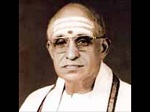Semmangudi Srinivasa Iyer

Chennai Oct. 31. “The last of the Titans has gone, it is the end of an era.” The cliches throb with new meanings when we join the mourners at his home in Lloyds Lane. No more will visitors find Semmangudi Srinivasa Iyer in the front hall, reclining on his easy chair, ready to greet you with his charming smile, impish jokes and pungent raconteuring about music and musicians.
Lionised as the patriarch of Carnatic music for his radiant singing, and for a scholarship that never stood in the way of his creative genius, Semmangudi’s stardom was assured even among great contemporaries like Ariyakudi Ramanuja Iyengar, Madurai Mani Iyer, Musiri Subramania Iyer and the glittering G.N. Balasubramanian. His will triumphed over a recalcitrant voice, its gruffness and nasality. The life-long tussle with the vocal chords could not stop Semmangudi from becoming the unrivalled musician of the century.
His concerts always drew full houses. In his 80s, he could still awe younger musicians by his ripeness and imagination. His swara singing dazzled always, but also seemed easy and effortless — until you tried to do it yourself.
Born in 1908 in Tirukkodikaval, in the home of his maternal uncle, violin maestro Krishna Iyer, young Cheenu’s talent in music was nurtured by violinist cousin Narayana Iyer. Rigorous gurukula training followed in Tiruvidaimarudur under gottuvadyam vidwan Sakharama Rao. He was to serve his concert apprenticeship with Maharajapuram Viswanatha Iyer, an artist as eminent as he was unpredictable. Cheenu was encouraged by the guru to craft his own style, where reverence for tradition fired originality. He was clear about his approach. “The deeper you go into a major raga, the more endless the journey, until the old things that you unearth will seem like new treasures.” Gimmicks were worthless, any value they had was short-lived.
Recognition came early to Semmangudi, both from audiences and from appreciative seniors. Veteran violinists and percussionists like Marungapuri Gopalakrishna Iyer and Thanjavur Vaidyanatha Iyer were happy to accompany the youngster on the stage. His appointment as the Principal of the Swati Tirunal Music College, Thiruvananthapuram, became a turning point. He notated and edited the compositions of Swati Tirunal for publication and popularised them on the stage. Semmangudi was to have one of his brushes with controversy over this project with Veena Balachander.
Unlike many great performers, Semmangudi was a good and generous teacher who trained a legion of disciples belonging to three generations. Those who learnt in the old gurukula way, staying in his home, recall how the master would render marvellous alapanas alone at night, usually after a concert. “Those who heard him then were privileged,” they say. M.S. Subbulakshmi deemed it an honour to learn from the maestro who enriched her style and repertoire. A single sample of their singing together has been preserved for posterity.
Such was Semmangudi’s veneration for the art he practised that everything he presented on the stage was gold — honed and burnished. Though his alapana and shloka singing showed he could do anything with ragas, evoke any mood or effect he wanted, Semmangudi did not compose songs, or even set too many compositions to music. “A lifetime is not enough to explore what we have inherited from our ancestors,” he would say. There was little that he did not know about tala, but he thought indulging in showmanship for its own sake was in poor taste.
For those who have known him on and off the stage as a wonderful artist and human being, the old home in Lloyds lane will continue to echo with memories. The music is in our hearts.
Ref : The Hindu






Leave a Reply